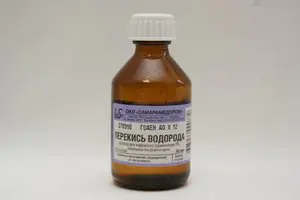
Hydrogen peroxide (peroxide) is a remedy known to everyone since early childhood. It is difficult to find at least one person who has never had their scratched hands and skinned knees treated with it. However, few people know that peroxide is widely used in cosmetology - in particular, it is used to get rid of bacteria that cause acne.
Hydrogen peroxide against acne
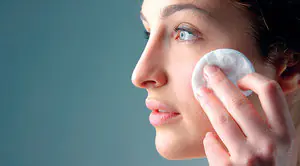
To treat the skin and prevent inflammatory processes in cosmetology, a three percent peroxide solution is used. There are also more concentrated formulations, but they are not suitable for use on the skin as they can cause serious burns. Moreover, even a three percent solution of peroxide against acne is not used in its pure form - it must be diluted before applying to the skin.
How does hydrogen peroxide work?
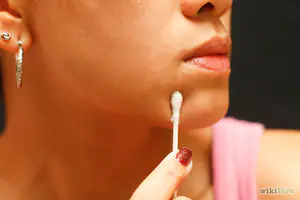
Using this substance, wounds on the skin are disinfected, cleansed of blood, pus and visible impurities. Peroxide does not have a sterilizing effect like alcohol, however, it reduces the number of bacteria at the site of application several times. When hydrogen peroxide interacts with the wound, oxygen is released and active foaming begins, which helps cleanse the skin. Oxygen leads to the death of pathogens, and a cleaned wound heals much faster. The substance has a similar effect on skin rashes: it removes dirt and disinfects.
Is it possible to smear hydrogen peroxide on acne? Yes, but you need to take into account the fact that peroxide will only help get rid of acne if it is caused by external influences. If the rash appears due to hormonal disorders or problems with the digestive tract, the effect of such treatment will be temporary.
Can hydrogen peroxide burn your skin?
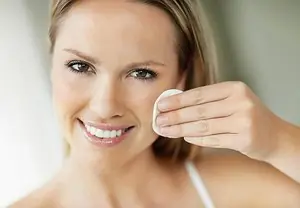
So how to use hydrogen peroxide? It was mentioned above that applying the solution to the face undiluted is strictly prohibited - this causes white spots to appear on the skin (in other words, chemical burns), and sometimes even tissue necrosis begins.
Only a freshly opened pimple can be treated with undiluted peroxide - in this case, you will cleanse the skin of residual pus and prevent the spread of bacteria. For such processing you will need clean cotton swab, which needs to be moistened generously in the solution and pressed several times onto the pimple. Such actions can be repeated no more than twice, since prolonged exposure to peroxide on the skin will not only not improve the condition, but can also cause tissue damage.
Peroxide against blackheads
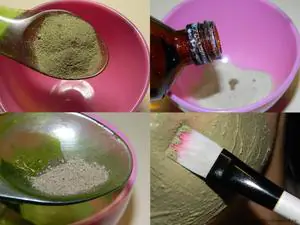
Black dots - a very unpleasant phenomenon that spoils both the mood and appearance. They appear on the face, in the T-zone (and sometimes on the cheeks), and are caused by exposure to dust and increased activity of the sebaceous glands. To get rid of this trouble, use various scrubs, peelings and masks. Regular soda, as well as a green clay mask, works very well against blackheads.
In this case, the use will not harm, but will not bring much benefit either - the substance will cleanse the skin and lighten it a little, but no more. Peroxide is combined with water in a 1:2 ratio and the face is wiped with this solution 1-2 times a week after using a mask or scrub.
Peeling for blackheads with hydrogen peroxide:
- Pour a teaspoon of sea salt with five tablespoons of a three percent peroxide solution. If the skin is sensitive, the resulting composition must be diluted with water in a ratio of 1:3.
- Rub your face with this solution for a minute, then wash thoroughly with clean water and apply moisturizer to your skin.
Procedure is quite aggressive, therefore it should be carried out no more than twice a month - otherwise the composition can cause serious damage to the skin.
Hydrogen peroxide for facial acne
Of course, the appearance of rashes on the face does not make anyone happy, and if pimples appear before some important event, it’s a big deal. Therefore, any means are good in the fight against them, as long as they are safe for healthy skin.
An effective remedy for acne
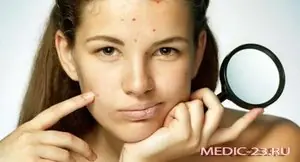
This the method is universal, it fights acne well, but only if the rash is not caused by any internal diseases.
- Boil a small amount of water and cool it to room temperature.
- Place 10 tsp in a clean container. prepared liquid and add 1 tsp. pharmaceutical peroxide solution.
- Apply the resulting mixture to your face twice a day, morning and evening, after your usual washing routine.
This treatment can be carried out for no more than two days in a row. If you do not notice any improvement during use (the rashes have not decreased in size or dried out), the reason for the appearance of acne lies in inside the body.
Masks against rashes
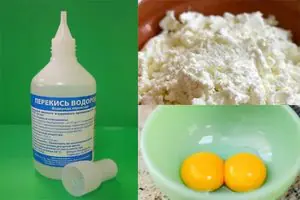
These methods are effective in combating acne, however, they can be used no more than once a week.
- Need to take a small amount of green clay and dilute it with peroxide to the consistency of thick sour cream. The resulting mixture is applied to the face for 5-7 minutes and washed off with water, and then a moisturizer is applied to the skin.
- Two tablespoons of dry yeast (beer's or baker's) are diluted with peroxide so that the mixture is quite thick but homogeneous. Apply this mixture onto pimples point by point, in three layers, waiting until the layer dries completely before applying the next one. After 5 minutes, wash off the mask with warm water.
- Take one tablespoon of honey and aloe juice, mix and add 2 drops of peroxide and iodine. Apply to inflammation for 15 minutes, then wash off.
- Several tablets of streptocide grind into powder. Take a teaspoon of streptocidal powder and the same amount of baby powder and dilute it with a peroxide solution to a liquid paste. Apply strictly to pimples, after the composition has completely dried, remove its remains with a cotton pad. Streptocide can be replaced with aspirin.
Whichever of the above methods is chosen, it should be remembered that the peroxide solution is strictly forbidden to be left on the skin for a long time, otherwise serious burns cannot be avoided. Therefore, thoroughly wash off the peroxide from your face and moisturize your skin with creamto avoid drying it out.
Safety precautions and side effects
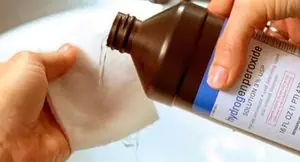
Hydrogen peroxide is a very strong product that can cause harm to the skin if used incorrectly, so it must be used with extreme caution. following all the rules.
- Undiluted solution peroxides should not be used on large areas of skin. Treatment of acne with a concentrated composition should be done pointwise, and not by wiping the entire surface.
- Do not use peroxide every day - this can cause not only burns, but even tissue necrosis.
- Carry out complex treatment, taking medications orally that help get rid of acne (of course, only after prior consultation with a specialist).
Although hydrogen peroxide is widely used as disinfectant, its use can be fraught with side effects:
- Long-term healing of wounds. Peroxide not only cleans the wound, but also burns it, as well as adjacent healthy tissue (which is why it is strictly forbidden to use it for treating piercings). Accordingly, using the solution too often will not speed up, but will significantly slow down the process of getting rid of acne.
- When exposed to peroxide, the skin may experience itching, flaking, or an allergic reaction.
Hydrogen peroxide is a cheap and very effective remedy that can relieve you of acne and its consequences. However, if rashes appear systematically, be sure to identify the cause of their occurrence and eliminate it with appropriate treatment.
Acne is a well-known problem among young people. But they often appear on more mature skin. There are many products on sale to combat them. But few people realize that it is possible to get rid of this trouble with more accessible and familiar medications that we know from childhood. The same hydrogen peroxide is a universal remedy that can eliminate many troubles. In addition to its well-known properties, it can rid the skin of acne and whiten it.
Effect of hydrogen peroxide
Its composition includes water and oxygen. When they come into contact with the tissues of the human body, they trigger an oxidation reaction. Oxygen combines with toxic substances, pollution and excess skin vapors. At the same time, bubbles form on the surface of the face, capable of pushing all unnecessary substances out. And the water resulting from decomposition is capable of washing away all these harmful elements from the skin.
As a result of the use of hydrogen peroxide, skin disinfection occurs. It dries, pigmented cells are removed from its surface, thanks to which the complexion brightens. Therefore, hydrogen peroxide is sometimes included in face masks for age spots.
But using it incorrectly can lead to skin burns. As a result, it can provoke the appearance of white spots, which will need to be treated with special medications. Therefore, it is necessary to strictly adhere to the dilution proportions of this product, and also add only the required amount to the masks.
The video talks about using hydrogen peroxide for acne:
How to treat leather
Buy 3% hydrogen peroxide. Dip a cotton swab into it and spot treat all pimples, trying to avoid contact with clean skin. Compresses and rubbing are excluded, because you can get a chemical burn. If acne is located in the deep layers of the skin, then the effects of peroxide will not be enough to eliminate them. Also, if after several sessions of treatment with this drug the acne has not changed in appearance, then the use of the drug should be stopped. It is necessary to find out the nature of acne and treat it with other means. You can learn about the use of hydrogen peroxide for the face against wrinkles by following the link.
To effectively use hydrogen peroxide, you must adhere to several rules:
- You cannot use a peroxide solution that has a concentration of more than 3%;
- if used frequently, the product may cause allergies;
- masks for dry skin should include natural moisturizing ingredients. Often they are: egg yolk, vegetable oil;
- avoid contact of the mixture with the mucous membranes of the eyes;
- Peroxide masks are mainly used for oily and problem skin;
- Before using any recipe, you should check your skin for allergic reactions. To do this, apply the mixture to the bend of your elbow and leave it for a quarter of an hour. Then rinse off and look at the consequences and sensations that may occur within an hour;
- It is necessary to apply masks with peroxide in a thin layer, distributing them evenly over problem areas of the face;
- the holding time should not exceed fifteen minutes;
- the course of treatment lasts a month. During this time, you can make no more than eight masks. After this you need to take a break for at least two months.
Video reviews about the use of hydrogen peroxide for acne and blemishes on the face:
Mask recipes
Before use, you should find out whether they can be used for your skin. Such formulations should not be used by people who may have:
- dry, flaky skin;
- individual sensitivity to the drug;
- various diseases (except acne and acne);
- wounds and skin injuries.
The video explains whether it is possible to wipe (cauterize) acne with hydrogen peroxide, and whether this procedure helps at all:
By the way, hydrogen peroxide will be needed for people who:
- oily skin;
- there are freckles and pronounced pigmentation;
- pores are enlarged.
Treatment with honey composition
To prepare a honey mask for acne, you will need to take one tbsp. a spoonful of honey and aloe juice, and add two drops of iodine and hydrogen peroxide to them. All ingredients are thoroughly mixed and then applied to problem areas. Leave for a quarter of an hour and wash off. This must be done, preferably with warm water.
Yeast for acne
To prepare a yeast face mask, you need to mash twenty grams of regular yeast with a fork in a ceramic bowl. Then add 1 tablespoon of peroxide solution to them. Mix everything until it reaches the consistency of sour cream. If using dry yeast, take the contents of half a sachet and add a small amount of water. After they dissolve, you need to add peroxide. This is the only mask that can be left on the face for twenty minutes. Then it is thoroughly washed off with warm water. During its action, you need to relax your facial muscles; this is best done while lying down. After using such a mask, you should wipe your face with chamomile decoction, which will soothe the skin and prevent dryness and irritation.
Purifying face mask
To prepare this acne cleansing mask, you will need shaving cream (you can use both women's and men's). One of his articles the spoon should be diluted in 50 ml of water (mineral or simply filtered), then add 5 ml of camphor or ammonia and 4 ml of hydrogen peroxide to the resulting mixture. Mix all ingredients carefully. Apply the composition directly to the face and wash off after a quarter of an hour. After using it, the pores will noticeably narrow and the skin will get rid of impurities.
From blackheads
Take two tablespoons of white clay, which can be purchased at the pharmacy. Then one tbsp is added to it. spoons of hydrogen peroxide and lemon juice. Everything is rubbed together and applied to the skin. And after ten minutes it is washed off with cool water. After this mixture, be sure to lubricate your face with cream. This product lightens the spots and removes dirt from them. It is especially effective if applied to steamed skin. An acne mask with lemon can be made with honey, without adding peroxide.
Using a curd mask
For it you need to take Art. spoon of homemade cottage cheese or heavy cream and combine with 8 drops of hydrogen peroxide. They should be mixed together, and if cream is used, the latter should be whipped and applied to the skin of the face. Leave this mask on for a quarter of an hour and then wash it off.
Anti-stain mask with badyaga
This component enhances the effect of hydrogen peroxide against acne and blemishes. It is able to eliminate long-standing spots and the consequences of post-acne. It is often used as a scrub. It is available for sale in powder and gel form. Badyaga can improve skin breathing and increase the supply of oxygen to all its cells. It serves as a conductor of peroxide for its deep penetration into the subcutaneous capillaries and participates in cleansing contaminated pores. This feature helps reduce the activity of the sebaceous glands.
To prepare the product, you need to take 5 grams of badyagi and 7 drops of peroxide. Mix all this and apply to your face. Leave for 10 minutes and rinse. This mask helps get rid of old and new scars, eliminate wrinkles and pimples.
This mask is contraindicated if you have:
- allergy to its components;
- thin and dry facial skin;
- rosacea;
- peeling is observed;
- hypertrichosis.
Face masks with peroxide are a real godsend for problematic and oily skin. They are able to cope with any acne that is not caused by internal diseases. Not only is the skin superficially cleansed, but deeper impurities are also removed. Using formulations with peroxide, you can get rid of annoying freckles and eliminate strong pigmentation on the face. Their correct use will lead to recovery of the skin from acne at any age.
Here you will find a description of the types and techniques of massage.
Reviews
- Zinaida, 54 years old: “Peroxide is a multifunctional drug. It can be purchased at a pharmacy at a meager price. This solution lasts for a long time. But I noticed that its effect decreases after intensive use of the bottle for a month if it is not stored in the refrigerator. I use hydrogen peroxide to dry out acne. I take a cotton swab, dip it in the bottle, and then apply it to the affected areas. Always helps."
- Lyudmila, 22 years old: “As a teenager, I was constantly plagued by acne, and as a result, acne left marks on my face. I tried to find suitable drugs to eliminate them. But it was difficult. Through trial and error, I gradually identified the top three, the use of which resulted in fewer acne breakouts. Until one day I had an appointment with a wonderful doctor - a dermatologist. He told me about a mask with peroxide and badyagi. And also convinced that if used correctly, the result will be very soon. He advised using this mixture twice a week and performing at least the minimum number of procedures. On average, they need to be done from 5 to 10 times. I didn't trust folk remedies. Still, I had a more powerful arsenal at home, consisting of three proven drugs. But I still tried this mask and did not regret it. After the third procedure, progress is obvious - the skin has become less oily, acne has decreased, and the areas around them have dried out. The only caveat: after using such a mask, the face remains red for some time. But during the day it goes away. That's why I always do it only at night. The next morning everything is fine.
- Nastya, 28 years old: “My sister and I have the same problem between us – acne. Purchasing effective medications and visiting cosmetologists is not cheap. Therefore, we decided to resort to traditional methods. They sometimes turn out to be much more effective than expensive pharmaceutical products. The choice fell on using a mask made from peroxide and cottage cheese. It's like combining business with pleasure. When you apply such a mask, you immediately seem to envelop yourself in a milky cloud, and under it the peroxide performs its healing effect. We noticed results of use after the second time. The skin has noticeably evened out, acne scars have become less noticeable. But this happened after an unsuccessful first attempt at using it, which was accompanied by a burning sensation. We couldn't last even two minutes, so we had to wash everything off. We probably added a lot of peroxide to the mask and almost got burned.”
Now let's keep the proportions. Apply the mixture to your face, take a lying position and enjoy the effect of the mask. We wait for it to dry completely and wash it off. Depending on the fat content of the cottage cheese, the duration of action of the product changes. It’s always different for us, but it lasts approximately ten minutes. After applying the mask, use moisturizer. We are very pleased with the result! We recommend this mask to everyone who suffers from acne and facial unevenness. With its regular use, the effect will not be long in coming. You can find out how to remove pigmentation from your face here.
Acne requires long-term and complex treatment involving medications for systemic and local use, hardware techniques, including alternative medicine in the form of masks, lotions, and compresses. Some people with skin problems use hydrogen peroxide for acne and leave positive reviews about its effectiveness. Others, on the contrary, doubt whether it is possible to smear hydrogen peroxide on acne, since it is a rather aggressive agent. Therefore, before starting treatment, you should weigh the pros and cons of using this substance.
General characteristics of the product
Hydrogen peroxide is known for its antiseptic properties. It is used to cleanse wounds of pus, blood residues and as an antiseptic. However, peroxide has been experimentally shown to prolong the healing period of wounds. This happens because the skin cells adjacent to the wound are damaged by the solution. This in turn can contribute to scar formation. In addition, the solution has a bactericidal effect not only against pathogenic flora. It also destroys beneficial inhabitants of the skin, which can cause a violation of local immunity.
Conclusion: peroxide is considered to be an “ambulance” in the treatment of acne, but is not an acceptable remedy for long-term use.
How does peroxide work on acne?
The main factors for the appearance of acne are an excessive increase in sebum production, the rapid rate of desquamation of epidermal scales and the proliferation of acne bacteria. As a result of their vital activity, bacteria produce enzymes that cause the appearance of inflammatory elements. Peroxide, when applied to the skin and when interacting with oxygen, quickly decomposes into singlet oxygen and water. It is active oxygen that has a toxic effect on bacteria and their number is sharply reduced.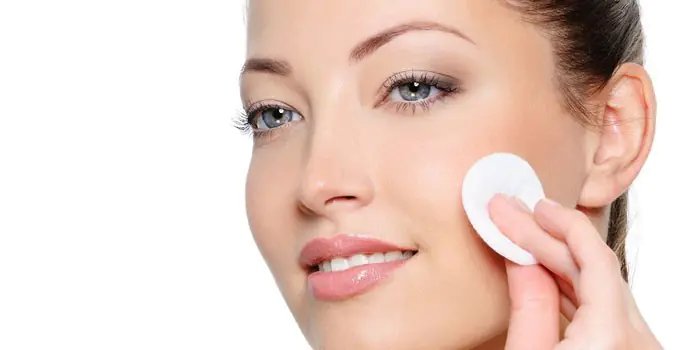
Hydrogen peroxide against acne works in several ways:
- removes pus by forming a hissing foam on the surface of the pimple;
- kills microorganisms, including acne bacteria, which are provocateurs of pustular neoplasms on the skin;
- Lightens pigmentation and stagnant acne spots.
It is ineffective and unsafe to use peroxide for acne on the face, which is located under the skin and for closed comedones. The solution works best with purulent acne when the necrotic contents come out. In this case, peroxide cleanses the ulcer well from the remaining purulent mass.
Important! Peroxide against acne only helps if the causes of their appearance are related to external factors. Acne caused by hormonal disorders, internal diseases, or those of a genetic nature can be treated with peroxide to no avail, since it does not affect the cause of its appearance.
Ways to use hydrogen peroxide against acne
The first thing you need to know is that wiping your face with hydrogen peroxide for acne is strictly prohibited if it is in undiluted form. Even in a small concentration (1-3%) the product can cause a burn to the skin, which manifests itself as white spots that do not go away for a long time. With a severe burn, tissue death may begin, which, even with timely treatment, will resemble an unsightly scar or pigmented mark. Therefore, you can treat a pustule from which purulent masses have drained with undiluted peroxide. In this case, it will cope with the following tasks:
- completely cleanse the resulting wound from pus;
- will prevent the penetration of pathogenic flora;
- will stop bleeding if they tried to put pressure on the abscess and damaged small vessels.
Therefore, to the question of whether it is possible to burn pimples with hydrogen peroxide, the answer is yes, but this must be done very carefully, trying to ensure that the product does not get on healthy areas. In order to cauterize the abscess, you should use a cotton swab. Moisten it generously in the solution and quickly apply to the eel. You may need to apply the stick to one place several times. It is important to remember that prolonged exposure can cause burns and tissue damage.
If acne covers large areas of facial skin, then you can wipe them only with diluted peroxide. To do this, take 1 part of peroxide and 10 parts of water at room temperature, pre-boiled. This method can be used for no more than 2 days in a row, lubricating areas with acne on the face twice a day.
Recipes using peroxide

Hydrogen peroxide for acne is used as a component of masks and tonics. Combination with other components reduces its aggressive properties for the skin, while maintaining the main effects.
It is enough to add a few drops to the lotion and wipe your face 2 times a week. The concentration calculation is as follows: 10 drops of peroxide per 100 ml of lotion.
Important! Any prepared product based on peroxide and other components should be tested for the presence of an allergic reaction before applying to the face.
To carry out the test, a small amount of the finished drug should be spread on the skin of the wrist, the inside of the elbow or behind the ear and left for 10 minutes. In the absence of irritation, redness and itching, it can be used as directed.
Multi-layer mask with yeast
You can apply the product prepared according to the following recipe directly to pimples:
- Grind brewer's yeast (sold in pharmacies as a dietary supplement) into powder.
- Add peroxide until the consistency becomes creamy (so that it sticks well when applied).
- Apply the mixture to each pimple. After drying, apply a second layer and then a third.
- After the last layer has dried, rinse with warm water.
Peroxide will clear the contents of rashes, and brewer's yeast will serve as a source of thiamine and biotin. In addition, yeast contains zinc, selenium and sulfur, which are necessary for normal metabolic processes in the dermis. This mask has an antiseptic and anti-inflammatory effect.
Aloe mask
Aloe or agave is the most effective plant in the fight against acne. Combination with hydrogen peroxide enhances the antiseptic effect of the latter.
The use of such a combined acne remedy performs several tasks:
destroys bacteria that, under favorable conditions, become pathogenic and cause pustular formations up to boils;
- promotes wound healing due to biostimulants contained in aloe;
- eliminates inflammatory processes (effective for numerous rashes);
- Lightens spots formed after acne.
To prepare a mask, just add 2 drops of peroxide to a tablespoon of aloe juice. This solution should be smeared on areas covered with acne or applied to spots. Leave for a quarter of an hour and rinse.
The effect of the product will be enhanced by the addition of honey, known for its bactericidal properties and containing a large amount of vitamins and minerals.
Brightening mask
Peroxide has lightening properties, but in its pure form it cannot be used for acne spots, as there is a high risk of burns. Therefore, it is combined with cosmetic clay and bodyaga.
- Bodyaga powder and clay are diluted with water (separately) to a consistency that allows it to adhere well to the skin.
- Add 5 drops of peroxide.
- Apply exclusively to scars and blemishes.
It is recommended to use this mask no more than 2 times a week.
Bodyaga in the composition helps to increase local blood circulation, removes dead epidermal cells, resolves stagnant spots formed after inflamed acne, and saturates the skin with oxygen, thereby improving metabolic processes and a faster process of cell renewal.
Recipe for blackheads
Peroxide is also used for acne, which is commonly called “blackheads”. These are open comedones, in which a mixture of sebum and dead skin particles has come out and oxidized under the influence of oxygen. Blackheads are mainly localized in the T-zone and on the cheeks. They do not cause physical concern, but they give the face an unkempt appearance. Scrubs made with sea salt or soda cope best with them. Add a few drops of hydrogen peroxide to any base and treat problem areas, applying the product in a circular motion. This scrub can be used no more than once a week.
Side effects and contraindications
If used irrationally, hydrogen peroxide for acne on the face can cause burning and redness. If these signs appear, use should be discontinued.
Peroxide as a single product is not suitable for people with very sensitive skin, because even a weak solution can lead to skin irritation. In this case, it should be combined with emollient components and used no more than once a week.
Treatment with peroxide is not carried out in the presence of dermatitis of any etiology and herpetic eruptions.
Briefly about the main thing
Experts in the field of cosmetology positively answer clients’ questions about whether acne can be treated with hydrogen peroxide, but they recommend taking into account the following:
- Apply a solution or mask based on it pointwise to each pimple;
- to lubricate large areas covered with acne, use a weakly concentrated solution, diluting 5-10 times with water;
- one area cannot be treated more than 2 times in 2 days, daily use is prohibited;
- combine peroxide with emollient components;
- for the face it is unacceptable to use a product with a concentration higher than 3%;
- use sunscreen while using the solution, as it may increase skin sensitivity to sunlight;
- after using peroxide, it is necessary to moisturize the skin to avoid peeling and drying; Avoid contact of peroxide with mucous membranes and healthy areas of the skin.
Conclusions
Whether hydrogen peroxide helps with acne in each specific case can only be found out by testing this remedy on yourself. You can come across reviews about the ineffectiveness of the solution, that at first the drug helped, but acne began to appear again. It is important to know that hydrogen peroxide does not affect the cause of acne, but only eliminates external manifestations. The same can be said about benzoyl peroxide for acne, whose action is somewhat similar to hydrogen peroxide. In any case, to achieve a therapeutic effect, it is necessary to take parallel medications that act directly on the causative factors.



